#clak'dor vii
Text
The Brass Killer goes after Max Rebo! Will Cad Bane stop the attempted murder in time???

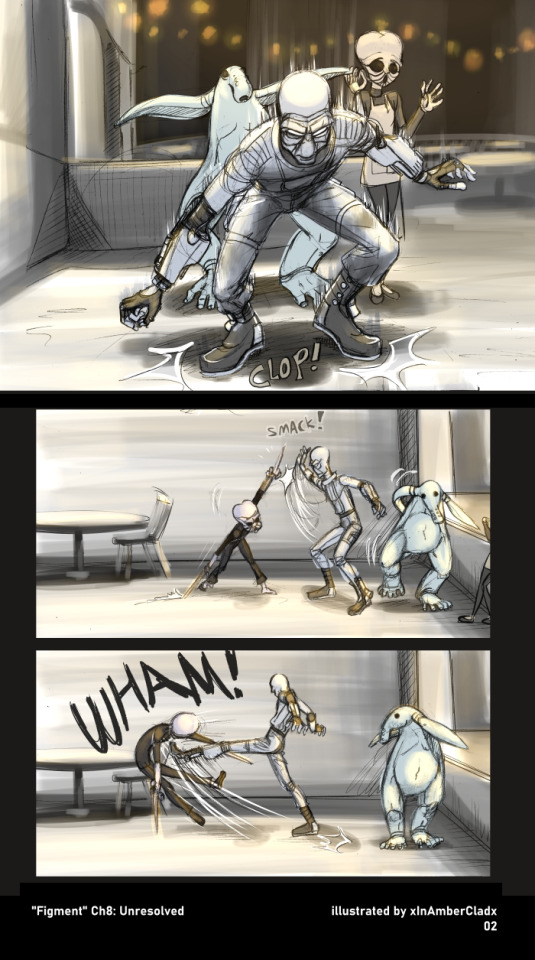
Of course he does. He's Cad F***ing Bane. :D yaaaaayyyy! Rebo is safe!
Chapter 8 is up, btw! >:D
Don't mess with musicians! This is a major spoiler for the Brass Killer arc in my fanfiction, "Figment" on AO3. <-click here to read. Why is the Brass Killer after poor Rebo? And why Cad Bane is involved? Cad Bane is no hero, he's a bounty hunter. He's "undercover" so to speak, since he didn't want the Brass Killer to recognize him. He chose a typical Duros spacer outfit. :D
But there's more to it than that. A lot more.... It's not over yet! lol more spoilers.

Has Cad Bane been double crossed??? Read the fic to find out! >:D
---------------------------------------------------------------------
xInAmberCladx's Fanart Archive <- click
#cad bane#max rebo#umpet saz#r'homden mili#duros#bith#ortolan#star wars aliens#i provide aliens while andor does not. lol#star wars#bounty hunter#clone wars#star wars fanart#clak'dor vii#bith homeworld#lamp lit restaurant#blueberry rescues another blueberry#I'm so happy i can draw Cad Bane again T_T#I couldn't for a bit there
60 notes
·
View notes
Text
So I thought up a fanfic idea so imma post about the MC to see if I should keep it to lore in my notes or make an ao3 fic. FYI this is set in star wars and would use cannon/legends at whenever I want.
Darth Malignus:
Darth Malignus was a project by Darth Vader that began in 16 BBY after being told the story of how Plaguis was created. Following this Vader left for Clak'dor VII and tried to request peaceful acess to the CMS. After being denied, he began an invasion of Clak'dor which took until 14 BBY. During the time, Vader began using the old hidden sith holocrons to study sith gene editing along with Plaugis'/Tenorbous' research.
After some searching he found a Gamoran Sow with high dark side potential and after gaining acess to the CMS found her a mate on Jedha. He began training the two in the dark side, and eventually they were two of the last people to get their kyber crystals on Ilum (Vader also using the dangerous strip mined Terran as a test)
After completing their combat training, Darth Malignus was conceived. Vader used combinations of Sith species and Night Sister magic to corrupt and threaten the quadruplets while an inquistor guarded the couple. Eventually, the sole surviving child was born. He was already slightly altered by the force.
The group would then move to an imperial base built during the pregnancy on Koroban where Malignus would be raised. He would come to be as strong as Gaelen Marek in his prime. After he begun traning with his lightsaber, a cracked crystal with a curved hilt and almost formed a proper blade edge, Vader would realize that Malignus' father began to move closer to the light. Vader order Malignus to execute his own father for this descent.
He would be declared the Moff of Korban's sector, and would abduct several children he encournted across the galaxy that he sensed the dark side in.
Eventually, a few months before the battle of Endor, he would wind up battling Luke Skywalker and upon learning that his master had been the Jedi chosen one he offered surrender in betrayal. Luke would spare him and allow him a chance to work for the light.
The children became a part of Luke's new jedi order, becoming the basis for the new version of the Grey Paladins. Malignus would do his best to aid ex-imperial planets and use his powers to destroy imperial remnant camps. Following this he would heal his lightsaber, never fixing the crack, and would study the balance of light and dark of Tython. He would die a monk on Tython, with his texts preserved after the death of the First Order and would die not knowing the path Luke went down or the fate of the order.
#star wars#star wars legends#star wars cannon sort of complient#sorry for spelling mistakes#writeblr#queer writers#fanfic#ao3#ao3 fanfic#darth vader#luke skywalker#sith
1 note
·
View note
Text
Star Wars Alien Species - Bith
Clak'dor VII, also known simply as Bith, was a small planet orbiting the large white star Colu in the Colu system of the Outer Rim Territories on the Rimma Trade Route. It was a long-time member of the Galactic Republic and was also the homeworld of the Bith species.

The Bith evolved over the millennia, and making use of their powerful senses of sight and hearing became a race of artists, scientists and musicians. They built great cities in the mountains and the jungles of Clak'dor VII. However, around 300 BBY, a conflict erupted on the planet between the capital city of Weogar and its domed counterpart Nozho over a stardrive patent. When subterfuge was detected by Weogar, war soon broke out and a chemical attack was launched by Nozho on the capital. The retaliatory biological strike on Nozho wiped the city out and destroyed Clak'dor VII's ecosystem, destroying the planet's ability to produce either the basic needs for its citizens or goods for export. The populace was decimated, though from the ruins of Nozho came the offshoot Y'bith subspecies who would go on to colonize Clak'dor IV. The surviving Bith on the planet were forced to relocate into domed cities, now proclaiming themselves pacifists and seldom venturing into the irradiated swamps, where the wildlife mutated into such lifeforms as the Ghhhk.

Clak'dor VII was represented in the Galactic Senate directly by Dodra F'ass until the planet seceded in 22 BBY, shortly before the Clone Wars. Though many Bith, like F'ass, retreated to their homeworld and seldom participated in battles, being pacifists, the Bith supported the Confederacy of Independent Systems with technological and artistic contributions: to the Bith, the Confederacy was opposing a morally corrupt Republic.
The Bith were horrified by the Galactic Empire, which persecuted them, necessitating an Alliance relief mission shortly before the Battle of Yavin, led by Nozzo Naytaan. Clak'dor VII was one of the first planets liberated by the New Republic (in 5 ABY, immediately after the New Republic campaign to Lwhekk).
After the planet's liberation, Clak'dor VII remained isolated for some time. It was not until a Bith ambassador witnessed the Hapans offer aid to the New Republic (and present Isolder as a gift to Leia Organa) that the planet joined the government.
Clak'dor VII was a New Republic stronghold during the Thrawn campaign.
The planet was represented in the New Republic Senate first by Nara Deega and later by E'noro. It was spared invasion during the Yuuzhan Vong War.


Bith were craniopods with pale pink, yellow, or (rarely) green skin, large heads, large lidless eyes, toeless feet, and long fingers with large finger pads and crosshatched fingerprints. Their thumb and small finger were both fully opposable. The Bith's internal systems were different from most humanoids, as the Bith had only one lung, and exhaled through their skin. Bith also lacked a proper nose, instead having highly sensitive olfactory organs hidden in the skin flaps of their cheeks.
The other Bith senses were also acute. Bith could sense the tonal qualities of sound as well as other races sensed colors. Their eyes, as big as a Menahuun's, were able to focus to 0.07 on the Gandok Scale, and they could see microscopic details of nearby objects, but were extremely nearsighted as a result. An interesting side effect of their incredible sensors was the effect of sonic grenades, or screamers, on them. It was described as causing their heads to explode. Similarly, Bith had high manual dexterity, which helped them manipulate fine tools, though their prowess with gross motor skills was only average.
Bith had evolved past the need for sleep. Instead, they would slip into a light meditative trance, which allowed them to get as much rest in four hours as other species could get in eight. During this trance, Bith were still almost fully aware of their surroundings.
A Bith's reproductive organs atrophied over time, as did the portions of their brain governing such impulses. As such, Bith were unable to reproduce naturally, instead relying on artificial conception and gestation. Mates brought genetic material to a Computer Mating Service for analysis against prospective mates. Bith children were created from genetic material from two parents, which was combined, fertilized, and incubated for a year.
A typical Bith stands at 1.7 meters or 5.6 feet tall and weighs 75 kilograms or 165 pounds.
Bith age at the following stages:
1 - 11 Child
12 - 15 Young Adult
16 - 50 Adult
51 - 70 Middle Age
71 - 84 Old
Examples of Names: Doikk, Figrin, Jinkins, Lirin, Nalan, Tech, Tedn, Thai.
Languages: Bith or Bithian was the native language of the Bith from Clak'dor VII. It was one of the official languages of the planet, the other one being Galactic Basic. Biths learned to speak and write Basic at a young age, being bilingual. The Bith language was numerical in structure; a distress call sent by C-3PO requesting an evacuation team translated to "Six-five. Twelve-seven-eight. Two-nine seven."
5 notes
·
View notes
Photo



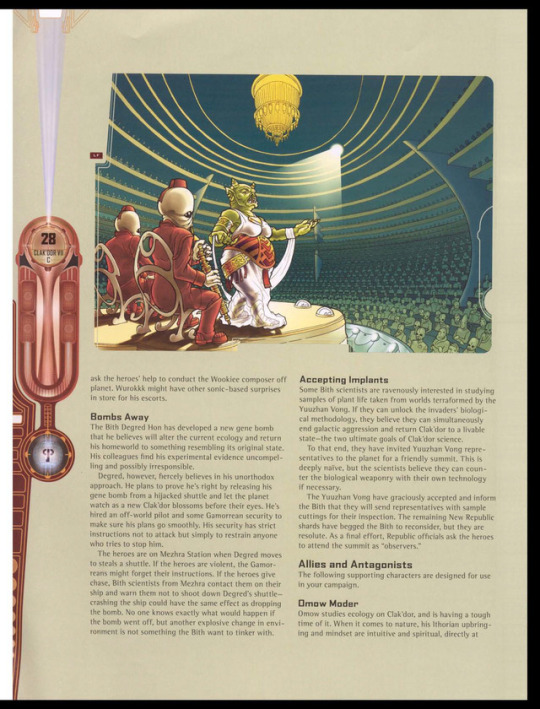

From the Geonosis and the Outer Rim Worlds sourcebook.
Another great find! I guess Sepal, and Taltos are going to have to learn Bith if the Nebula Front relocates to Clak’dor VII. This certainly seems to be a fitting chioce for raising a family of idealists whilst being in close enough proximity to Eriadu. Reorganizing the Nebula Front will be no small feat. Seems they didn’t cause much of an uproar for almost 30 years! I can honestly see them just lying low and plotting for awhile. I’m sure all the survivors and new recruits will exercise greater caution in their affairs.
Also, Taltos knows better than to stir up any violent trouble here. He’s got a family to think about now. Moreover, a world with any substantial Stormtrooper presence would honestly give Sepal neverending anxiety attacks. Oh! Oh! And Pistis is going to be surrounded by the arts! How cool is that!? It’s easy to imagine Taltos embracing an unschooled education for his daughter on a planet such as this.
0 notes
Photo

Bith were a peaceful, highly evolved craniopod species native to the planet Clak'dor VII. Fully adapted to a civilized, high-technology lifestyle, Bith were found galaxy-wide at all levels of society, most notably as engineers, scientists, intellectuals, consultants, and musicians.
82 notes
·
View notes
Photo

The legendary Star Wars Cantina Band have been entertaining audiences since 1977. A long time ago, we asked them to perform at our event, but alas, the planet Clak'dor VII, where they live, is just too far far away for them to travel. Undeterred, we looked a little closer to Tatooine and found The Cantina Band Quartet, who'll be delighting the crowds at Sci-5 by the Sea, with their quirky, groovy and jazzy sound. Bringing to life TV and Movie themes, including Star Wars, Ghostbusters, Dr Who and many more favourites, and of course, the Cantina Song, everybody now 'doo be doo be, doo be doo....' Sci-5 by the Sea, Herne Bay takes place on Sunday 25th June and If you'd like to come along, then don't delay grab your tickets today from http://ift.tt/2lmB0C5 (£9a, £7c (u16) (u3 no charge), £27 (2a2c). Tickets also available from Peters Produce, Kids Korner Toy & Fancy Dress Shop and The Activity Box. http://ift.tt/2kRn1aF
0 notes
Text

Cad Bane enjoying a meal, good music, and ambiance at the Bayou Dinner restaurant on the Bith homeworld, Clak'dor VII.
No, he does not have his hat. He lost it on Naboo. This is right after the episode "Children of the Force" after he escapes the Jedi at Black Stall Station. He's laying low for a bit. Yes, his breathing tube is out of his cheek! He was tired and fell asleep before removing it. Derp. His cheek hurts so he took it out. You can read more about this scene in my fanfic "Figment". Linked below.
Read "Figment" on A03
Chapter 5 will be posted in, like, 15 minutes!
I imagine the culture of the Bith to be a mix between New Orleans and the Caribbean side of Mexico, with a deep love of music and seafood. Oh yes. This chapter will make you hungry for seafood. haha.
----------------------------------------------------------------
xInAmberCladx's Fanart Archive
#cad bane#on his day off#laying low#enjoying a good meal#He ate blue shrimp fritters#citrus infused water#swamp oysters#bith homeworld#Clak'dor VII is a swamp planet#bounty hunter#duro#duros#completed bounty#Clak'dor VII#Bith culture#star wars#star wars fanart#fanfiction
115 notes
·
View notes
Text
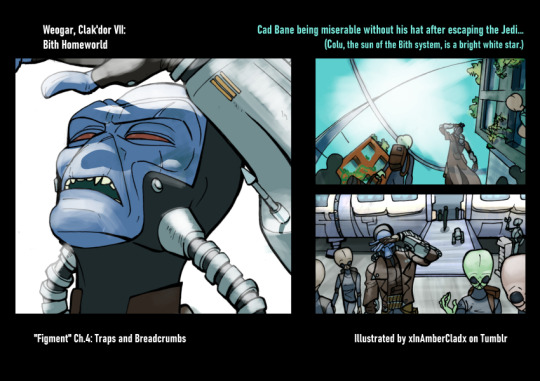
Context: After escaping the Jedi and the explosion at his secret hideout Black Stall Station, Bane goes to Clak'dor VII to lay low for a while. Unfortunately, his hat is lost to the swamps of Naboo. He misses it dearly. D:
HAHA. Cad looks like an old man here. But don't we all look older when we're squinting at the sun? XD Minor spoiler illustration for my fanfic "Figment" on AO3.
Read "Figment" . Chapter 4 releases today!
Did you know Biths come in more colors than just beige? Green, yellow and pinks too! <3 They're so cute. I loved drawing them. I'm definitely drawing more for Chapter 5!
---
xInAmberCladx's Fanart Archive
#cad bane#cad bane fan comic#star wars#star wars fan comic#children of the force#bounty hunter#duros#fanart#clone wars#bane lost his hat#bith homeworld#clak'dor vii#bith#music capitol of the galaxy#my things 2022
107 notes
·
View notes
Text

People keep saying Cad Bane is a bastard man. Yeah. I agree. But does he ever feel conflicted about it? Maybe.
MAX REBO DOES NOT HAVE ARMS. The original maquette sculpt AND the original suit did not have arms. He plays the Red Ball Jet Organ with his FEET. He's super young here, like just after his teenage years and just starting his music career. Bane hooked him up with a gig, but has ulterior motives... using Rebo as bait to catch the Brass Killer.
Read "Figment" on AO3 <- click
---------------------------------------------
xInAmberCladx's Fanart Archive <-click
#cad bane#max rebo#what if they were friends?#star wars#duros#bounty hunter#clone wars#fanart appreciation#fanart#star wars fanart#fanfiction#clak'dor vii#ortolan#max rebo does not have arms#max rebo band#having a meal#bros bonding#fellow blue fellas#two blueberries#an elephant and a lizard walk into a BBQ joint...
60 notes
·
View notes
Text

Chapter 6 has been released! I decided it was too long. I split it into two separate chapters. I got some stuff going on right now, so I won't be able to get much selfish fanart drawn or fanfiction written this week, so here you go. Enjoy.
Read "Figment" on AO3 <- click
Cad Bane investigates a murder scene in his hunt for the Brass Killer, his latest Bounty. He meets another interested party, R'homden Mili. These are the illustrations I did for it.
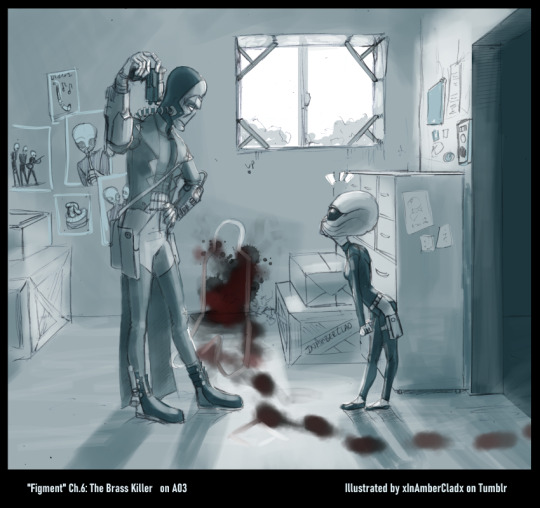
----------------------
xInAmberCladx's Fanart Archive <- click
#cad bane#fanfiction#fanart#illustrations#fan illustrations#bith#bith homeworld#clak'dor vii#star wars#duros#bounty hunter#clone wars#star wars fanart#Bith OC#R'homden Mili#she lost her holdout blaster to Bane#he's not impressed
34 notes
·
View notes
Text

While investigating a crime scene, Cad Bane runs into another interested party, a Bith woman named R'homden Mili.
-----------------------------------------------------------------
<strong>Excerpt from "Figment" Ch6: Bait and Allure</strong>
“Pardon my lassoin’ you, Miss Mili. I get jumped every now and again on jobs. Tell me why you’re skulking ‘bout crime scenes.” Bane looked her over again, “And without armin’ your holdout blaster first?” He spun it around his finger as deftly as a Bith would a drumstick.
“Wah!? How did you?”
“Didn’t think dat one through. You need to treat death like it’s ‘round every corner, Miss.” He stuck the small blaster in his belt, as it was too small for his empty LL-30 holsters. It felt good having a weapon on his person again.
Mili's shoulders dropped. “Who are you? Can I have my pistol back?”
“You lost yer chance to be the one askin’ questions.” He towered over her, “I’ll ask one last time before makin’ ya scram. What bid’ness ya have wit Saz?”
Read "Figment" on AO3 <- Click
*Ch6 will drop soon*
** He lost his hat on Naboo, and the Jedi confiscated his weapons before he escaped Obi-Wan and Mace Windu during the self-destruct of Black Stall Station. This happens right after so he's laying low on the Bith homeworld, Clak'Dor VII.
---------------------------------------------------------------------
xInAmberCladx's Fanart Archive
#cad bane#r'homden mili#duros#bounty hunter#bith waitress#murder investigation#bounty hunt#the Brass Killer is on the loose!#holdout blaster#fanfiction illustration#star wars fanart#clone wars fanart
22 notes
·
View notes
Text
I seem to like writing two plots at once...
For example, having the main characters trying to solve a problem, and that's Plot A. Then at the same time, they have to solve another, minor problem or another subplot is happening in the same scene with other characters.
Figment Ch.10 (rough draft in progress).
Plot A: Cad Bane goes to the hangar to meet with Todo so he can finally leave the planet Clak'dor VII.
Plot B: Todo parked poorly so Bane has to deal with an angry dude in the hangar because of it.
This isn't really a spoiler. Both these mini plots take place over a single page. I find that relatively "Boring" or "simple" scenes can be made more interesting just by adding a subplot. Plot A and B both are used to lead into Plot C, which is a serious conversation between Bane and Todo.
#the whole of ch.10 is about dealing with trust issues and sketchy behavior of nearly every character#or rather#sketchy behavior that leads to trust issues#writing#writing process#writing advice#a plot and b plot#subplots#mini plots#cad bane#star wars#fanfiction writing#how to make a boring scene more interesting
6 notes
·
View notes
Text
Star Wars Alien Species - Gamorrean
Gamorr was an agrarian planet located in the Opoku system of the Outer Rim Territories. It was the homeworld of a porcine sentient species, the Gamorreans (derogatorily known as pig-lizards). Its varied terrain ranged from frozen tundra to deep forests, and was considered quite pleasant by off-worlders.
When the first offworld traders landed on Gamorr, five Gamorrean clans fought for the right to approach the vessel. When one clan won the right to approach after two days of battle the victorious Gamorreans walked up to the trading vessel and smashed it into pieces. Six further trading expeditions suffered the same fate before a heavily armed vessel was sent with a new aim, to take the Gamorreans as slaves. After this initial contact, the galaxy found more productive uses for the Gamorreans.

As a result of their physical characteristics and low intelligence, Gamorreans away from their home planet or colony were usually employed as mercenary fighters, guards, bounty hunters or heavy laborers. Gamorreans would generally work for anyone if the price was right and the nature of the work was to their liking. They would even accept slavery if the terms were right. A draw-back for some employers in hiring Gamorreans was their contractual requirements. They generally did not consider a contract binding if it was not sealed in blood by way of combat. Since traditionally a Gamorrean warlord would force a recruit to fight to prove his ability, they expected a prospective employer to do the same. From their perspective if an offworlder could not defeat those that they hired then they were not worth working for. Though prized as mercenaries, their strong clan allegiance and hatred for rival clans made it unwise to hire groups of Gamorrean enforcers without first inquiring about their clan backgrounds. A number of species, including Sullustans, found Gamorrean females attractive, and many found work as belly dancers.
During the Jedi Civil War, Gamorreans were known to be involved with the Exchange and to take innocent beings prisoner, keeping them as slaves, taking particular interest in Wookiees. By the time of New Sith Wars, particularly the period between 1042 BBY and 1032 BBY, large numbers of Gamorrean warriors fought alongside Sith troopers under the banner of Sith Lords such as Chagras, Odion and Daiman, participating in raids and massacres. Due to these actions Gamorreans were considered cruel and merciless monsters, and their bad reputation survived into the times of the Galactic Empire. At least one, however, was intelligent and civilized enough to be the sergeant-at-arms for the New Republic Senate.
Gamorrean sows were not as commonly sighted off Gamorr or Pzob. Notable exceptions were female traders such as Ugmush, Captain of the Zicreex, who traveled from Gamorr to nearby worlds trading goods. A Gamorrean sow also performed at the world famous Purghom Musical Performance Hall on Clak'dor VII". A large group of sows settled on the asteroid G'aav'aar'oon and formed the religious order known as the Nuns of G'aav'aar'oon. They opened their convent as a medical facility, and took a pacifist approach to life, in contrast to the typical Gamorrean philosophy.

Gamorreans were organized into clans ruled by a male warlord and his wife, a head sow who was the most powerful of the clan matrons. While the warlord and his boars were solely concerned with preparing and participating in battle with rival clans, the matrons of the clan performed all the productive work including farming, hunting, manufacturing weapons and running businesses.
Females within a clan were all related to each other and could trace their lineage back to a common matriarch. Boars, however, were exchanged between clans at an early age and some would change their allegiance during their adult lives. Clans ranged in size from a few dozen to over a hundred but typically a clan constituted about 20 sows, fifty boars and the young. The young were mostly born in the spring ("slushtime") and the litters typically ranged between three and nine. The male to female ratio was about ten-to-one with females only being born about every second litter. Despite this, a high fatality rate among boars, due to their violent lives, resulted in a predominance of older females.
Clans owned and controlled areas of land and were always interested in acquiring more. Land was gained by either colonizing unclaimed areas or more commonly taking land from rival clans. Since the amount of available arable land on Gamorr was scarce several clans often laid claim to the same piece of land, and they spent their time fighting over possession. A female typically had up to a dozen husbands during their lifetime since a boar's lifespan was limited by his violent lifestyle.
Sows did all the useful work within Gamorrean society and they owned and leased all property. They were capable of being as rough as the males and they actively encouraged boars to engage in bloody act of violence to demonstrate their virility. Daughters inherited their mother's land evenly and therefore over generations these holdings diminished in size. A matron consolidating land was a critical reason for the ongoing wars between clans.
Clan matrons were a select group of sows with the greatest of land who constituted the clan council of matrons. They usually had a number of clan Tusker boars in admiration of their beauty and status. A matron could often be distinguished from a lesser clan sow by the presence of a small number of bodyguards and the relatively large number of morrts that they hosted. The council of matrons was led by a head sow who were the richest and most powerful of the clan matrons.
Sows were responsible for all trading with non-Gamorreans. They were typically interested in obtaining weapons and food supplies with long lives. They would pay for such goods with gold or other precious metals if they had any or by boar mercenary contract.
There were four classes of male boars within Gamorrean society: Warlords, Clan boars, Tuskers and Veterans. Warlords were the most socially and physically powerful boars in a clan and held their position by way of their marriage to a clan matron. The greatest of the warlords was selected by the head sow for his combat prowess and past successes. He was absolute ruler in all matter of war and general of the clan armies. The lesser warlord served as clan captains. A typical warlord could host up to twenty morrts and they were known to bestow them on other warriors for acts of heroism. Warlords almost always came from the ranks of the household boars (otherwise known as Tuskers).
Clan boars were males married to clan sows (not matrons) and they made up the core of the clan-guard and the clan army. They were important individuals because the income provided by their wives enabled them to afford good weapons and armor. Their relatively high status (below warlords) was indicated by the 10 or so morrts that lived on their bodies. They could generally not attain the position of warlord unless their wife died and they married a matron or she inherited a matronage, both rare events in Gamorrean society.

Tuskers or household boars were unmarried males who were pledged to a clan. They formed the bulk of the clan armies and generally lived off the plunder of military campaigns. While a tusker was customarily poor they could hope to gain the attention of a sow or perhaps even a clan matron and therefore enter the ranks of the Clan boars or Warlords. They typically hosted about half a dozen morrts but a successful tusker could amass a much larger trove. They would often give a clan matron their morrts as tribute. Tuskers were not totally loyal and would occasionally change their allegiance to another clan particularly if the clan matron was looking to increase the size of her clan.
The fourth basic variety of boars in Gamorrean society was the Veteran. They were retired from campaign due to old age or more commonly from a maiming or injury. A veteran could often be identified by the lack of a body part and the presence of about twelve or so morrts. They were typically very tough, experienced boars who were well respected within their clan. They were responsible for the training of the young boars before they first marched off to war and were trusted advisors to clan Warlords. They also often commanded the clan-guard.
Gamorrean youths often kept gelatinous slimes from the planet Saclas as pets.
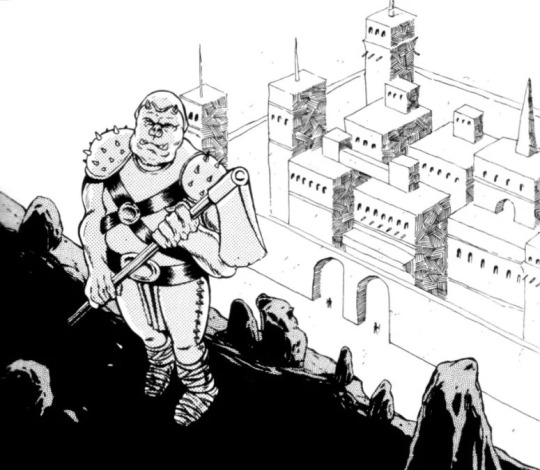
Gamorrean clans constructed fortresses that varied in size dramatically. They all tended to follow the basic design. The simplest fortresses consisted of a stockade surrounded by a small village of huts and long houses. The clan-guard controlled the boundary of the fortress and kept unwanted visitors away. They domesticated dangerous predators called Watch-beasts to help protect these strongholds. Access to the settlement was through a gate and at the center of the village was typically the clan-house. This was a well constructed, heavily fortified building where the matrons and warlords resided. A small fortress would be inhabited by about 10 sows and 20 boars.
An average fortress consisted of a village with a stockade that could be surrounded by a moat or other boundary defense. An internal sub-fortress was usually built around the village on a built-up or naturally occurring mount.
The sub-fortress was a well-built construction that was sometimes built of stone and it was well guarded. In its function, the sub-fortress was a large version of the clan-house. An average Gamorrean village of this size would typically be inhabited by between 30 and 50 sow and as many as 100 boars. Immediately inside the main gate of the village was located a common area. This was a place where markets were held and it represented a safe area for other clan members. It was a serious crime to violate the strict no fighting rules in this area.
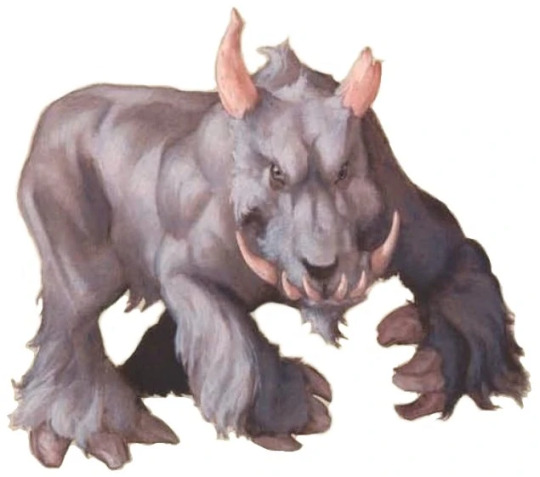
Some of the most powerful and prestigious Gamorrean clans had larger fortresses that were effectively townships. The town was surrounded by an outer wall fortifications and a broad moat. It was often also divided internally by walls to reduce the impact of an enemy that advanced passed the main gate. There were several clan-houses in the internal structure and a sub-fortress that acted as a final refuge against an advancing army. Only about a dozen townships of this size existed on Gamorr and was populated by as many as 100 sows and 300 boars.
Several of these larger fortresses have constructed a foreigners' quarter within their boundaries where other clans could deal with each other in safety. Like the common area of smaller settlements there was a strict prohibition of combat in this area. Non-Gamorreans were often found trading in these areas. Most towns maintained a large landing field outside of their boundaries.
Some of the larger clan-towns formed sub-clans that still considered themselves part of the parent clan although local rivalries between sub-clans did develop. It was debated among Xenosociologists whether the development of these large clan-towns marked a societal change within the Gamorrean clan structure or whether these clan-towns would eventually collapse under population and social pressure.
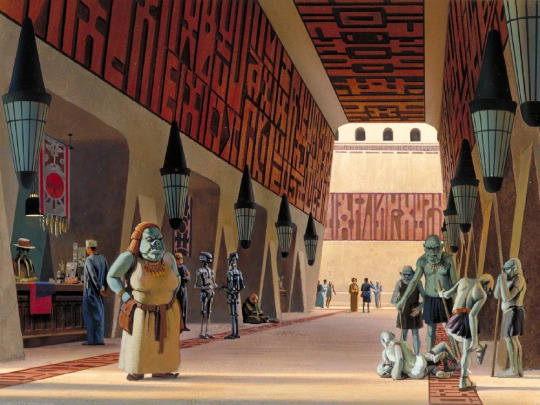
Some clans formed small professional mercenary bands that move around selling their combat services to the higher bidder. Although it was not exceptional for fashionable clans to occasionally fight for another clan for pay, these mercenary clans did it professionally. They were, however, not totally driven by greed and the warlords of these clans still adhered to the tradition of fighting a blood-battle to complete a deal. Since these clans would go somewhere to carry out a contract they constituted a significant quantification of Gamorrean mercenaries in the galaxy.
The warring clans of Gamorr never united under the banner of one planetary government and therefore the Gamorreans did not have representation in the Galactic Federation of Free Alliances.
Although Gamorreans were not known for their sensitive nature they were especially demonstrative when it came to their morrts and were particularly loving toward their children and mates. Signs of affection included a tackling hug and a punch on the snout. Indeed, knocking a mate unconscious was considered a prelude to mating, although the initiator had to make sure they had smelling salts at hand if copulation was the intention.

The activities of the Gamorrean clans on Gamorr were dominated by the seasons. Spring was called slushtime because of the melting of the winter snow and the abundance of rain and resultant perpetual mud. The wet conditions of early slushtime resulted in plentiful harvests of short-term fungi and provided a start for the longer growing moulds. During this period the veteran boars trained the younglings in combat and the unattached tusker boars roamed the land looking for adventure and opportunities. Early slushtime on Gamorr was a depressing time, the constant rain and dark gray skies often resulted in many Gamorreans feeling grumpy and miserable. Since Gamorreans idealized emotions of strength and ferocity it was not a polite subject to discuss their emotional degeneration in this regard. Most sows gave birth at this time which was about a gestation period from the return of the boars from campaigning in autumn. Mid-slushtime was also traditionally the time for marriage and for negotiating and finalizing Clan alliances and mercenary contracts. It was also the time when young boars were exchanged for fostering and the clan matrons readied their warriors for war in the summer. Toward the end of this season, clans tuskers tended to initiate raids against rival clans in order to prove their boarness.
The summer season was called Wartime and initiated a period of military campaigning, often in retaliation for the raids in late-slushtime. The boars, unmarried sows (sometimes derogatorily called "v'lch") and young boars in training marched off to war. They left behind the matrons, married sows, elders and a small guard of boars to defend the settlements and fortresses. The military strategy of Gamorrean warfare was quite basic and involved attacking, plundering and the occupation of land. In early-wartime the clans participated in a number of small scale battles during which time each side probed the strength of the opposition for weaknesses. By the middle of the campaigning season the Gamorrean warriors had settled into the business of besieging opponents fortresses and as the temperature increase toward late-summer grand battles were fought as forces attempted to break from a besieged position.
By the end of the summer period, the clans had spent the majority of their strength. There were a few late skirmishes in autumn (Croptime) as the clans made their way back to their homes in triumph or otherwise and by mid-croptime they had settled in for the winter. During this period, the sows and drafted tuskers harvested the crops and autumn fairs occurred as newly wealthy clans traded plundered goods and crops. The fairs also operated as a forum for the forming of new clan alliances. Also during this season, widowed sows advertised their availability and married, tales of heroic battles were told, wounded boars ceremoniously join the ranks of the veterans and the clans feasted for the last time before the coming of winter.
Winter was called Coldtime and was a period of freezing temperatures and fierce storms on Gamorr. Clans that were too depleted during the summer campaigning season would often find themselves starving and this sometimes resulted in sporadic winter raids. In the more successful and affluent clans, life was more comfortable. Boars became docile and romantic, courting their wives as young tusker males did. This behavior by the boars continued into early spring when the first seasons flowers were picked and presented as gifts to the sows. The unmarried tuskers spent the winter worshiping a matron from a distance, planning for the next seasons combat and playing table games. During the winter and early slushtime, some skilled Gamorreans would ride sleds pulled by semi-domesticated Dwoobs as a method for transporting goods. They were generally only used by skilled sled drivers and most used simple wheel-barrows to transport goods.
Gamorreans were Animistic and believed that everything such as natural features, animals, sites of past battles and people had an enduring spirit that could affect the physical worlds. The superstitious beliefs of the Gamorreans, however, decreased over the last hundred years or so before the Battle of Yavin. Although they believed that everything had a lingering spirit, they were generally only concerned with powerful spirits that could pose a threat.
Famous long-dead heroes, giant trees, large fungi, the spirits of murdered individuals and ancient fortresses are an example of things that Gamorreans believed could help or hinder the living. The association with how these spirits affected the physical world was based on the nature of the source in Gamorreans lives. For example, tree and mountain spirits were generally considered good because the source, with which they reside, provides wood and stone for building. This, however, did not mean that they believed that they were totally benign since trees would drop branches on individual and mountains would shed landslides onto unsuspecting Gamorreans.
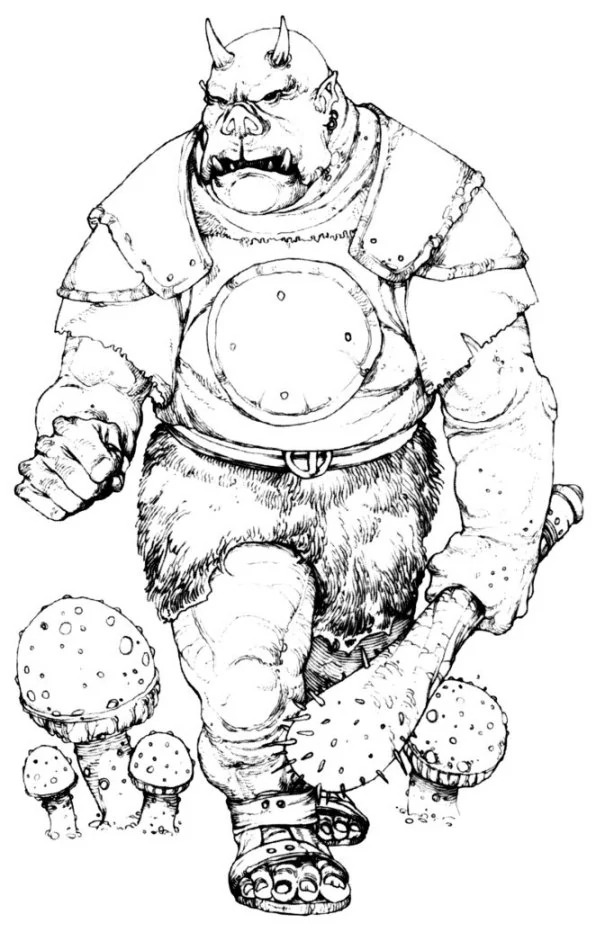
The spirits of the sea and forest were considered incomprehensible. Sometimes, they would let a traveler past and other times, they would hinder their progress. Forests were viewed as mischievous, they would change the path and, on occasion, swallow an entire fellowship whole. Gamorreans didn't like the oceans as they saw them as incredibly unpredictable. If treated correctly, they thought that the spirits would send favorable wind, and if angered, they would unleash a ferocious storm. Even if the spirits sent favorable wind and current they believed that the spirit, on occasion, decided to sweep the traveler far out to sea or draw the vessel into a watery grave.
They believed that ancient fortresses had powerful and good spirits that could fortify the strength of defenders during an attack. Famous warriors who fell during an attack on a fortress were also invoked to increase the defenders strength. Such spirits were thought to protect a certain clan and they also included a powerful warlord who fell in combat, who was invoked to ensure victory in battle, and most importantly the spirit of the clan founder. The clan founder was a matron and it was believed that she sent dreams to the incumbent clan matron to advice in time of strife.
An ancient clan fortress and giant fungi were thought to house fertility spirits. In the case of the fortress spirit, it was believed to increase the fertility of sows during slushtime and croptime. They believed that giant carnivorous fungi, such as the Algark stalks, contained fertility spirits because they would dispense their spores (offspring) when approached. As such, the Gamorreans respected these spirits from afar.

The spirit of a murdered individual was greatly feared by most Gamorreans. They were thought to be angry at being killed by underhand means and intent on seeking revenge against the murderer. These spirits were believed to walk the land of the living during the night, seeking retribution and killing all that they came across. According to the Gamorrean beliefs, they were exceptionally strong and dangerous but did not possess supernatural abilities such as invulnerability or the ability to fly and could therefore be physically fought by a warrior. Since the surest way to prevent the spirit from entering the physical plane was to kill the murderer, justice was often swift on Gamorr and Pzob.
The fallen in great battles were thought to reside at the site of their demise and were believed to return during stormy winter weather to re-fight the battles. Since battles typically took place near settlements and fortresses, storm damage to these dwellings were often attributed to the spirits.
Although a typical Gamorrean was squat, green, and heavily built not all shared these characteristics. Most Gamorreans had a dark greenish coloration over a large portion of their bodies; however skin coloration did vary, particularly among females, with light skinned and two-toned pigmentation not uncommon. Black, brown, pinkish yellow, and even a rare white pigmentation were possible. Boars tended to have less skin variation and had a greater tendency towards dark green skin perhaps because of their higher exposure to the radiation of the Gamorr Star. Eye coloration varied evenly between gold-yellow, blue, black and brown. The Gamorreans generally put no importance on skin or eye coloration although there were some superstitions linked to certain markings.

Not all Gamorreans were heavy and squat. Although this was the most common and generally the desirable appearance in Gamorrean society some individuals were comparatively lean and tall. Greel, co-owner of the The Broken Tusk on Reuss VIII, was quite undersized compared to his brother Gorge who represented a more conventional Gamorrean appearance.
They were largely viewed as mindless, intellectually inferior brutes by the wider galactic community. This perception may have been partly due to their physiology, which made it nearly impossible for them to speak Galactic Basic. Their vocal apparatus made it impossible for them to speak clearly in any language other than their native language.
Gamorreans were typically covered by a number of parasitic bloodsuckers native to Gamorr called morrts. They showed great affection for the creatures and considered them adorable pets. The number of morrts that a Gamorrean hosted was related to their status within a clan. A clan Warlord or Matron could have up to 20 of these parasites feeding on them.
The Gamorrean diet mainly consisted of fungus that grew plentifully on their homeworld. A species of mobile mushrooms called Snoruuk was one of the most widely eaten varieties along with Fug. They drank an alcoholic beverage called Potwa beer.
Newly born Gamorreans were called "feeders" until they were weaned. Once weaned the younglings were called "shoats" until the age of 3 when they began gender specific training.
Gamorreans average about 1.8 meters or 5.9 feet tall, weights 140 kilograms or 309 pounds.
Gamorreans age at the following stages:
1 - 6 Child
7 - 12 Young Adult
13 - 29 Adult
30 - 39 Middle Age
40 - 44 Old
Examples of Names: Gartogg, Jubnuk, Ortugg, Ugmush, Venorra, Warlug.
Language: Gamorreans speak Gamorrean. They have no written version of the language. They can learn to understand, but not speak other languages.
9 notes
·
View notes